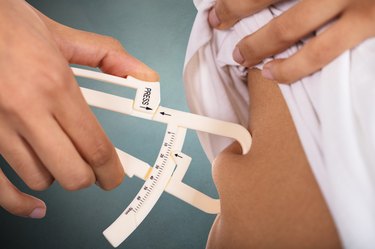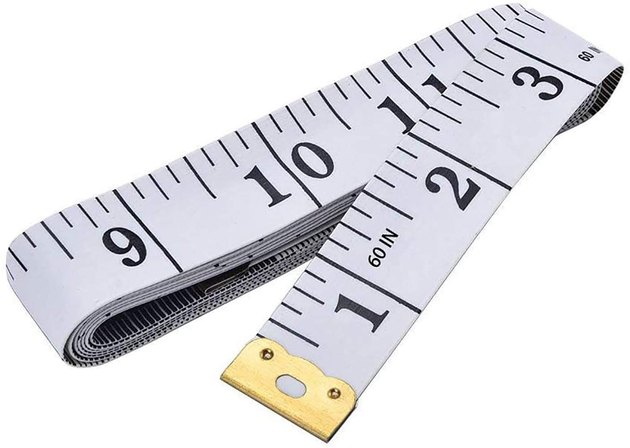
The scale doesn't lie — or does it? While the tool can be helpful in tracking your progress toward your fitness goals, it doesn't always give you an accurate assessment of weight loss or where you are in your journey to better health. In fact, in some cases, a daily weigh-in may even be misleading.
For example, if exercise is part of your slim-down plan, you're likely burning fat and building muscle at the same time. That's a good thing, because muscle is more metabolically active than fat, which means it helps you burn more calories at rest. But because muscle is denser than fat, the scale is going to show that you gained weight. And while that might be true, it doesn't give you the full picture of what's really going on in your body.
Video of the Day
Video of the Day
So, how to weigh yourself without a scale?
Luckily, you don't have to be a slave to the device to figure out if you've lost weight. There are several other factors that can clue you in and may even give you a more accurate picture of your gains.
1. Invest in Measuring Tape
Although it might sound old-fashioned, a measuring tape is a useful tool to tell how much you weigh without a scale because your waist and hip circumferences can be strong indicators of fat loss, Ilana Muhlstein, RDN, registered dietitian nutritionist and co-creator of Beachbody's 2B Mindset nutrition program, tells LIVESTRONG.com.
The key is knowing how to measure yourself correctly. "There is a large margin of error given that a person may place the tape in a different spot or pull on the tape harder from one measuring point to another," Muhlstein says.
Here's how to accurately measure yourself, according to Muhlstein:
- Make sure to measure in the same spot each time. A great way to remember placement is by using your belly button as a reference point, or by snapping a picture of where you are measuring by standing in front of a full-length mirror.
- Once you find your spot, hold the tape parallel to the floor, grip it in a relaxed fashion and record the number after a normal exhale.
Other places you can measure are the chest, upper arm, upper leg and lower leg, adds Heather Gunn Rivera, certified personal trainer and co-founder of Grass Roots Fitness Project. However, keep in mind that when your muscles grow, these measurements might increase as well.
When using a measuring tape to track weight loss, don't expect to see changes right away. "These measurements can be helpful but may take longer to show dramatic changes," Rivera explains. She recommends taking your measurements every six weeks.
Try These Tape Measures
2. Go Shopping in Your Closet
Not sure if you're losing weight? "You can always tell by how those skinny jeans fit," says Jillian Michaels, a celebrity health and fitness expert and creator of the My Fitness by Jillian Michaels App.
"Within the first 5 to 15 pounds of weight loss, your clothes should fit differently," Muhlstein says. "Within the first few weeks, my clients love to tell me that they are happy to shop in their own closets and wear the clothes that they already owned but weren't comfortable wearing."
Once you stay consistent with your weight loss and surpass that initial change, some items may even begin to fall off, including rings and pants.
3. Test Your Body Fat

Your body fat percentage is a measure of your fat tissue versus lean mass, aka bone and connective tissue.
A higher body fat percentage, even if your total weight is normal, means you are vulnerable to the same health issues associated with obesity, including heart disease and type 2 diabetes.
When you measure your body fat every month or two, and it decreases, you know you've lost weight in the form of fat, even if your weight or pant size hasn't changed.
"When we feel good, we don't hold on to things we don't want, and that includes weight."
There are home methods to estimate body fat, such as smart scales. However, accuracy varies for these products, Muhlstein warns. A more accurate way is via a DEXA (Dual-energy X-ray Absorptiometry) Scan, which is primarily used to measure bone density, but these instruments are very pricey and not accessible to most people, Rivera says.
One of the easiest and most accessible way to measure your body fat is to seek out a certified personal trainer, who will use body calipers to pinch the skin at various sites around your body, including the triceps, abdomen and thigh.
Use a Body Fat Calculator
A simpler method involves taking your measurements, in inches, at select points of your body. Once you take these measurements, you can input them into an online calculator, such as LIVESTRONG.com's Body Fat Calculator, to estimate your percentage.
4. Snap a Few Selfies
There is a reason why before-and-after photos are such #fitspiration on social media — and Michaels is all for them. She encourages her clients to visually document their journeys by taking photos along the way.
Not only does it hold you accountable, but it also allows you to see your body's changes (and celebrate them!).
5. Get a Checkup

Michaels stresses that your yearly physical is the most important thing when it comes to measuring your weight loss and overall health goals.
"People always ask me what a healthy weight is," she says. "My answer is that it isn't about the number on the scale — it's about the numbers you get back from your doctor, such as cholesterol, blood pressure, blood sugar and inflammatory markers."
Reducing your body weight by just 5 to 10 percent might not seem like a big deal on the scale, but weight-loss statistics show it can markedly improve these measures and set you on a path to long-term health, according to the Obesity Action Coalition.
6. Consider How You Feel
If you've been eating better, working out and sleeping well, you'll feel it — regardless of what the numbers on the scale say. Workouts might seem easier, and you'll notice you have more energy during the day. Old photos and a simple once-over of yourself in the mirror also tell you where you are on your weight-loss journey.
"Health and feeling good in our bodies should be the goal," Rivera says. "In the end, it's about accepting the body you are in, and learning to appreciate what it is capable of."
And don't underestimate the power of positive vibes, she says: "When we feel good, we don't hold on to things we don't want, and that includes weight."
Ready to Lose Weight?
Set yourself up for success with more from LIVESTRONG.com's Weight-Loss Kickstart.
- Psychology Today: "Do You Suffer From Scale Addiction?"
- Today's Dietitian: "When Thin Is Fat — If Not Managed, Normal Weight Obesity Can Cause Health Issues"
- Weight Watchers: "Taking Measurements"
- Shape: "The Best (and Worst) Ways to Measure Body Fat"
- Centers for Disease Control and Prevention: "Losing Weight"
- Mayo Clinic: "More on Body Fat Cutoff Points"
- Obesity Action Coalition: "Benefits of 5-10 Percent Weight-loss"

